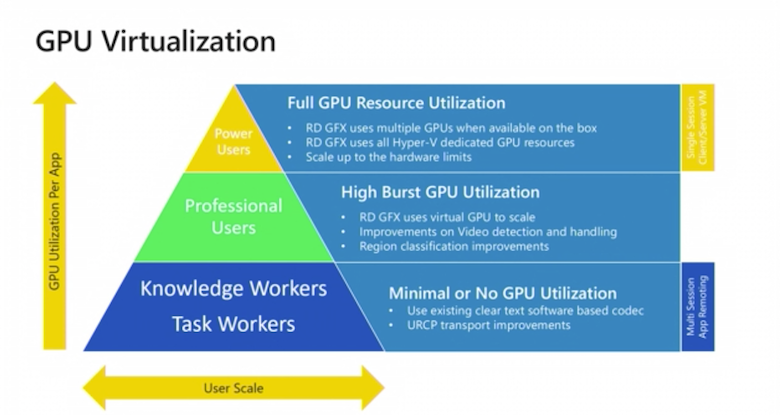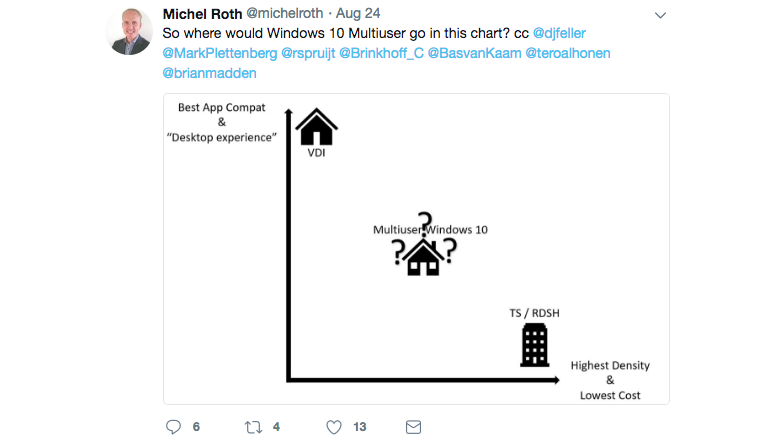Seriously, what is multi-user Windows 10 for? (Another possible clue?)
We know it’s coming, but we still have no clue what Microsoft is thinking.
(Update: If you're reading this after Ignite 2019, we have all the answers now! See my piece on the Windows Virtual Desktop announcement!)
All summer, we’ve been talking about the new multi-user Windows 10, or “Windows 10 Enterprise for Virtual Desktops,” if you prefer.
In March, Brian’s article declared that RDSH was dead after it disappeared from a Server 2019 preview, possibly in favor of multi-user Windows 10, but then RDSH came back.
Now, we know that multi-user Windows 10 exists and is coming, and plenty of community members have been poking and prodding it. Bas van Kaam has published a useful overview of all the facts to date.
But really, we still have more questions than answers. What is Microsoft really thinking? What’s the true use case? How many users will it support? (Yesterday, Tero Alhonen got it up to 21 sessions.)
At this point, it’s safe to assume we’ll find out a lot more about it in just 2½ weeks, at Ignite. But in the meantime, I want to kick off another round of discussion.
Another possible clue?
First, I’d like to enter one more possible clue into the conversation.
Disclaimer: After thinking about this clue for a while, I’m pretty sure it’s useless, but since this is a blog and I’m the executive editor, I’m still going to put it out there.
Anyway, a few days ago I was editing an article by Rachel Berry (on the future of RemoteFX, due out tomorrow), and I stumbled on this slide (below). It’s from a video called “Hybrid track: Remote Desktop Services on-premises and Azure,” from Microsoft’s online Windows Server Summit in June.

The slide was a little fuzzy, but notice that the top of the pyramid reads “Power Users: Full GPU Resource Utilization: Single Session Client/Server VM” and the base of the pyramid reads “Knowledge Workers/Task Workers: Minimal or No GPU Utilization: Multi Session App Remoting.” The middle slot reads “Professional Users: High Burst GPU Utilization,” but does not specify multi versus single session.
Again, let me qualify that I’m just putting this out there, but my initial thought was “Hey, Windows 10 multi user could fit in that middle slot!” There’s no context in the talk track to suggest this, though—it was purely a visual thing, and after some thought, I’m not sure how much this makes sense (hence all the disclaimers).
Still, the idea of multi-user Windows 10 as a middle ground between regular VDI and RDSH is hard to shake. It also reminds me of this chart tweeted by Michel Roth.

In the long term, I’m actually leaning towards the camp that if multi-user Windows 10 exists, why do you need RDSH? I agree with Brian on this one—he said: “Like, for real, if Win10 Multiuser is a thing, why is RDSH a thing too?” (Denis Gundarev had some good comments in this direction, too.)
One other idea that came up in a conversation this week is that the highest scalability—in terms of sessions per unit of physical hardware—may not necessarily correspond to having the greatest number of sessions per VM. There could always be a Goldilocks session-to-VM-to-hardware ratio, so the fact that Windows 10 multi user doesn’t support a huge number of sessions doesn’t necessarily restrict it to small scale use cases. We’ll have to see what testing and licensing terms reveal once it’s out.
Back to the big conversation
Anyway, you just have to think that something big is happening. People have noted how oddly Microsoft handled the missing RDSH in the previews this spring. (A bug?!) Something has got to be up, right?
For example, maybe it makes sense for Microsoft to add a DaaS offering to Microsoft 365? It would sure go well with Windows 10 S Mode. Or, what if you could manage virtual desktops and apps directly with Intune?
Ignite is coming soon—what do you want out of Windows 10 multi user?








